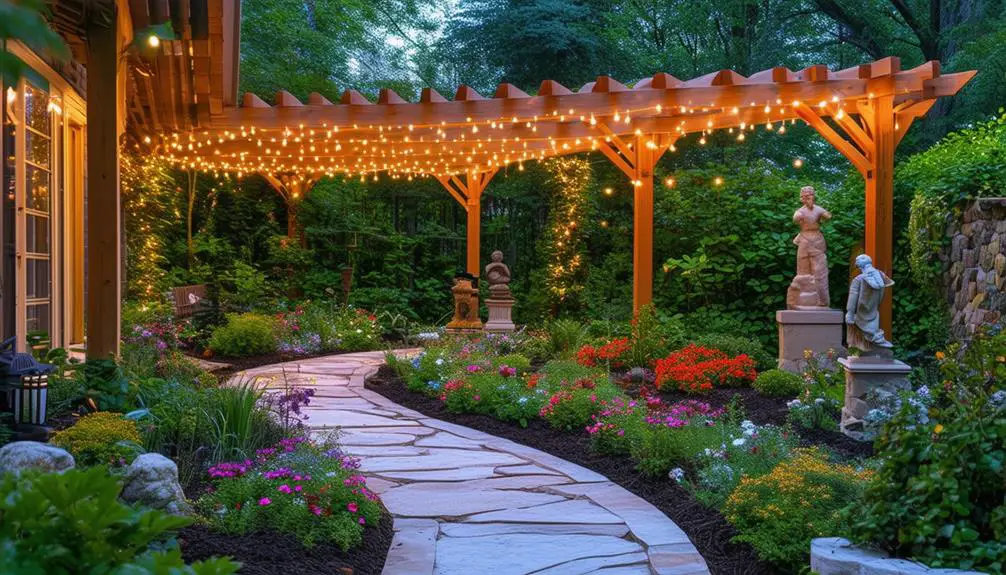When it comes to cultivating a thriving jade plant, the key lies in mastering a few essential techniques. From selecting the right pot size to providing adequate sunlight and humidity levels, each step contributes to the overall health of your plant.
But there’s one important factor that often goes overlooked, a secret to enhancing your jade plant’s full potential.
By understanding this critical aspect and implementing it into your care routine, you’ll set the stage for a lush and vibrant jade plant that will captivate all who see it.

Key Takeaways
- Choose a pot 2 inches larger with drainage holes.
- Place in bright, indirect light indoors.
- Use well-draining soil mix to prevent root rot.
- Water deeply, allowing soil to dry out between waterings.
- Maintain temperatures between 65-75°F for optimal growth.
Choosing the Right Pot
What size pot should you choose for your jade plant to ensure proper growth and development? When selecting a pot for your jade plant, it’s vital to take into account the pot size, drainage, material, and aesthetics.
Jade plants thrive in pots that allow for proper root development and drainage. A pot that’s 2 inches larger in diameter than the plant’s current pot is generally a suitable choice. This extra space provides room for the roots to expand without being excessively large, which can lead to overwatering issues.

Ensure the pot has drainage holes to prevent water from pooling at the bottom, which can cause root rot. Clay pots are a popular choice for jade plants as they allow the soil to breathe and excess moisture to evaporate. Additionally, the weight of a clay pot provides stability for top-heavy jade plants.
When it comes to aesthetics, choose a pot that complements the natural beauty of the jade plant while also fitting well with your home decor. By selecting the right pot size with proper drainage, material, and aesthetics, you can create an ideal environment for your jade plant to flourish.
Selecting the Ideal Location
When selecting the ideal location for your jade plant, take into account its light requirements, temperature preferences, and humidity levels.
Make sure that your plant receives adequate sunlight, with indirect light being the most suitable. Jade plants thrive in moderate temperatures, ideally between 65-75°F, and they prefer low humidity environments.
Light Requirements
For the best growth of your jade plant, position it in a location that receives bright, indirect sunlight for the majority of the day. Jade plants thrive in environments with moderate to high light exposure, making them ideal for spaces with ample natural light.
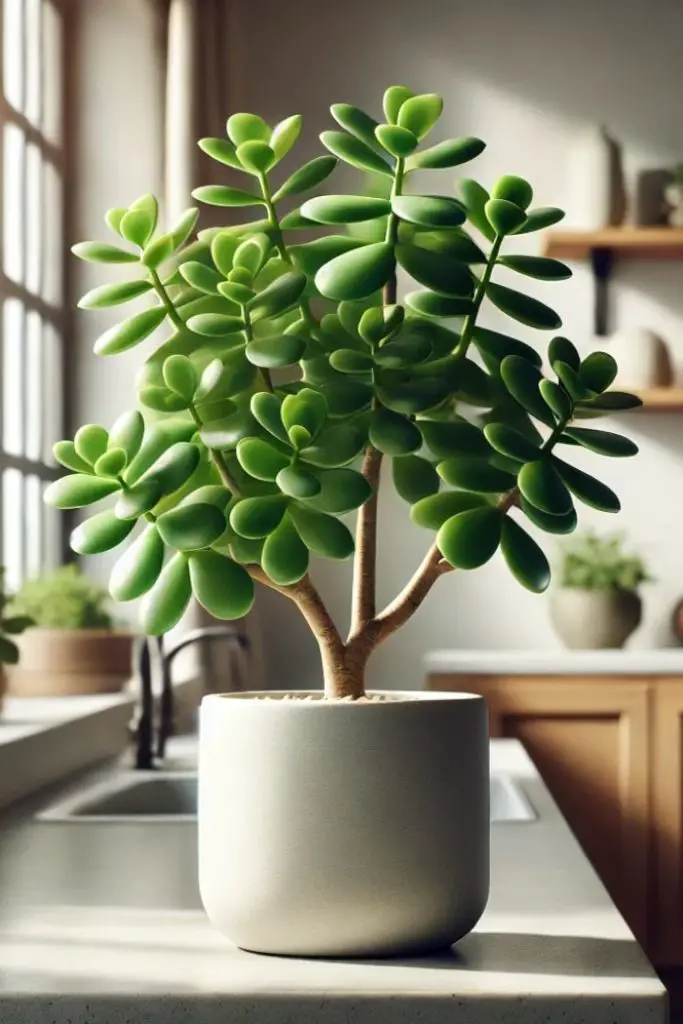
Make sure that your plant isn’t placed in direct sunlight for extended periods, as this can lead to leaf burn or discoloration. Indoors, a spot near a window with sheer curtains or blinds to filter the sunlight is perfect. Outdoors, consider a location where the plant is shielded from intense afternoon sun.
Temperature Considerations
For the best growth of your jade plant, consider the temperature requirements when selecting its ideal location. Jade plants thrive in temperatures between 65-75°F (18-24°C) during the day and slightly cooler at night. Avoid placing your plant in areas with ideal temperature fluctuations as this can stress the plant and affect its growth.
Seasonal adjustments are essential for peak plant care. During winter, make sure your jade plant isn’t exposed to cold drafts, and in the summer, protect it from direct sun to prevent overheating. Monitoring the temperature around your jade plant and making necessary adjustments will create a conducive environment for its growth and overall well-being.
Humidity Levels
Consider placing your jade plant in a location with ideal humidity levels to guarantee its healthy growth and development. Jade plants thrive in moderate humidity, typically between 30% to 60%. High humidity can lead to issues like fungal diseases, so maintain good air circulation around the plant.
Low humidity can cause leaf drop and slow growth. To maintain suitable humidity levels, you can place a humidifier near the plant or use a pebble tray filled with water to increase moisture in the air. Understanding the plant’s growth patterns and adjusting humidity accordingly will promote ideal conditions for your jade plant.
When propagating jade plants, maintaining consistent humidity levels is essential for successful propagation techniques such as leaf or stem cuttings.
Providing Proper Drainage
To guarantee proper drainage for your jade plant, it’s essential to use well-draining soil that allows excess water to flow through easily.
Select containers that have drainage holes at the bottom to prevent water from pooling around the roots, which can lead to root rot.
Use Well-Draining Soil
Make sure the jade plant’s soil is essential for maintaining a healthy jade plant. Proper drainage is vital for maintaining a healthy jade plant. To achieve this, use a well-draining soil mix that consists of a combination of cactus mix and perlite or sand. The cactus mix provides the necessary nutrients, while perlite or sand aids in drainage by preventing the soil from becoming compacted.
When watering your jade plant, make certain that excess water can easily flow out of the bottom of the pot. This will help prevent water from pooling at the roots, reducing the risk of root rot. By using a well-draining soil mix, you can create an ideal environment for your jade plant to thrive.
Choose Suitable Containers
Make sure that the containers you choose for your jade plant provide proper drainage to prevent water stagnation and root rot issues. The container size should allow for adequate root growth while also ensuring excess water can easily drain out.
Opt for materials like terracotta or ceramic, which are porous and help with moisture regulation, reducing the risk of overwatering. These materials also offer a range of aesthetic options to complement your indoor or outdoor decor.
Containers with drainage holes are essential for maintaining a healthy root system by allowing water to escape freely. Consider the overall look and feel of the container to enhance the visual appeal of your jade plant while prioritizing its growth and well-being.
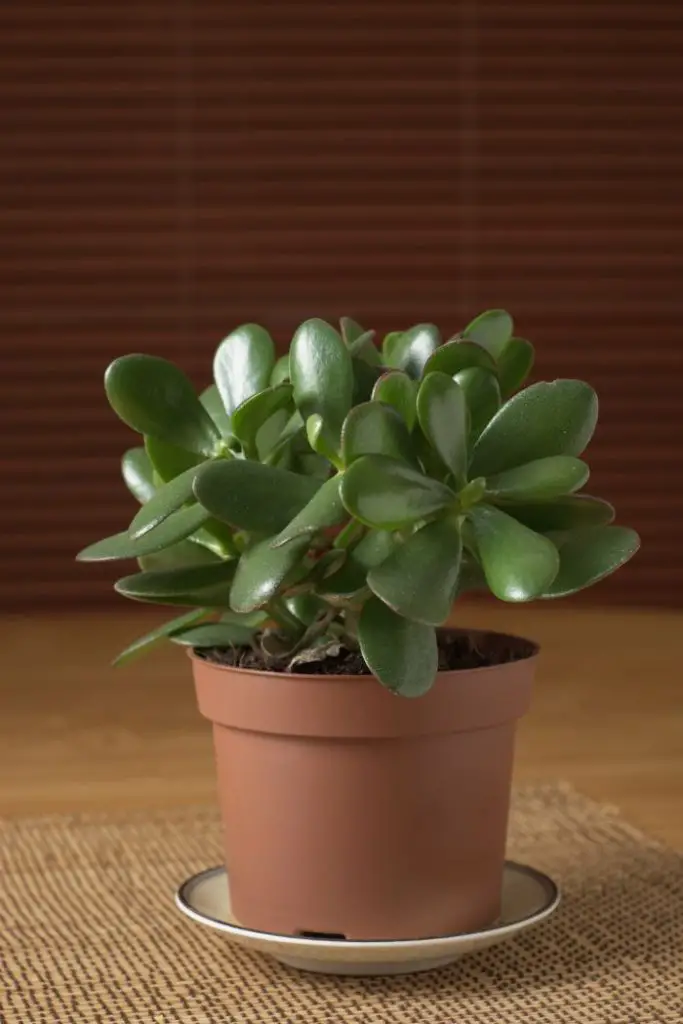
Add Drainage Holes
Consider drilling drainage holes in the bottom of your container to guarantee proper drainage for your jade plant. Essential drainage is vital to prevent waterlogged soil, which can lead to root rot. When watering your jade plant, make certain that excess water can easily escape through these holes, preventing water from pooling at the bottom of the container.
For best growth, jade plants prefer well-draining soil that consists of a mix of cactus soil and perlite or coarse sand. This type of soil mixture allows for proper aeration and drainage, essential for the health of your plant.
Using the Right Soil Mix
Wondering what type of soil mix is best for your jade plant? To guarantee your jade plant thrives, it’s important to use a well-draining soil mix. A combination of succulent or cactus potting mix with perlite or coarse sand works best for jade plants. This mix provides the necessary aeration and drainage to prevent root rot, a common issue with jade plants.
When creating your soil mix, aim for a composition that’s light, airy, and quick-draining. Jade plants prefer slightly acidic to neutral soil with a pH level around 6.5. The succulent potting mix provides the right balance of nutrients while the perlite or sand aids in drainage, preventing waterlogging.
Avoid using regular potting soil or mixes that retain moisture for too long, as this can lead to root rot. By using the appropriate soil mix, you’re establishing the foundation for a healthy jade plant that will flourish with the right watering techniques and pruning methods.
Watering Your Jade Plant
When watering your jade plant, it’s important to maintain a proper watering frequency to prevent issues like root rot. Watch out for signs of overwatering, such as yellowing leaves or mushy stems.
To guarantee your jade plant thrives, adopt best watering practices like allowing the soil to dry out between waterings and using room temperature water.
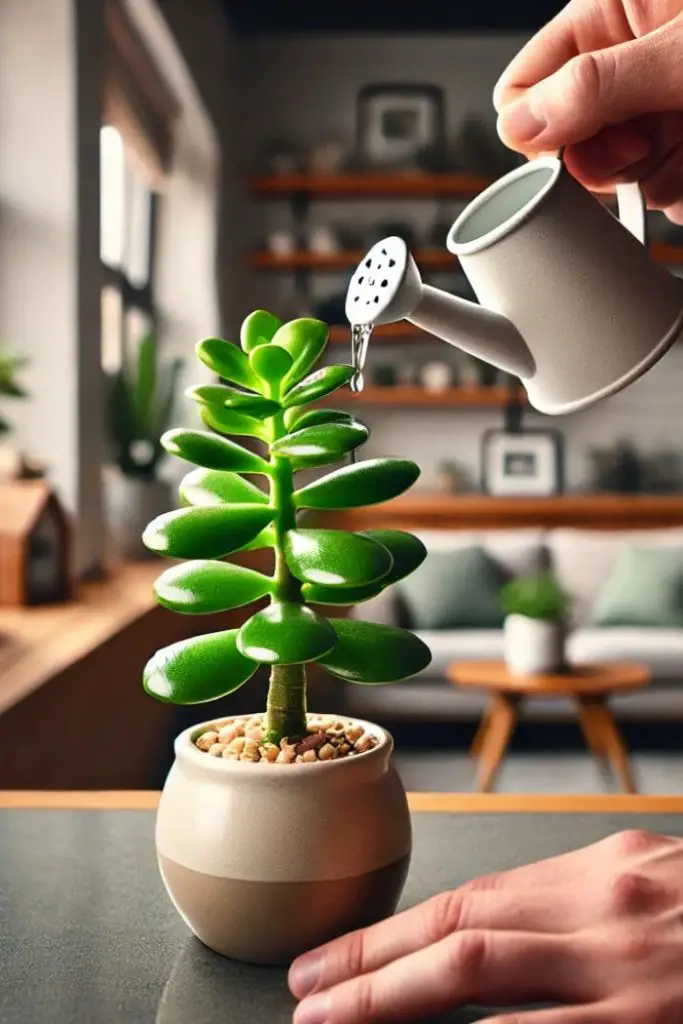
Proper Watering Frequency
Regularly check the moisture level in the soil of your jade plant to determine when it requires watering. For best growth, practice deep watering by ensuring the water reaches the roots.
During dry periods, increase the frequency of watering, but always allow the soil to dry out slightly between waterings. Use a well-draining potting mix to prevent waterlogged conditions that can harm the plant.
Water your jade plant until you see excess water draining from the bottom of the pot, indicating thorough hydration. Remember, the frequency of watering will vary depending on factors such as temperature, humidity levels, and the size of the plant.
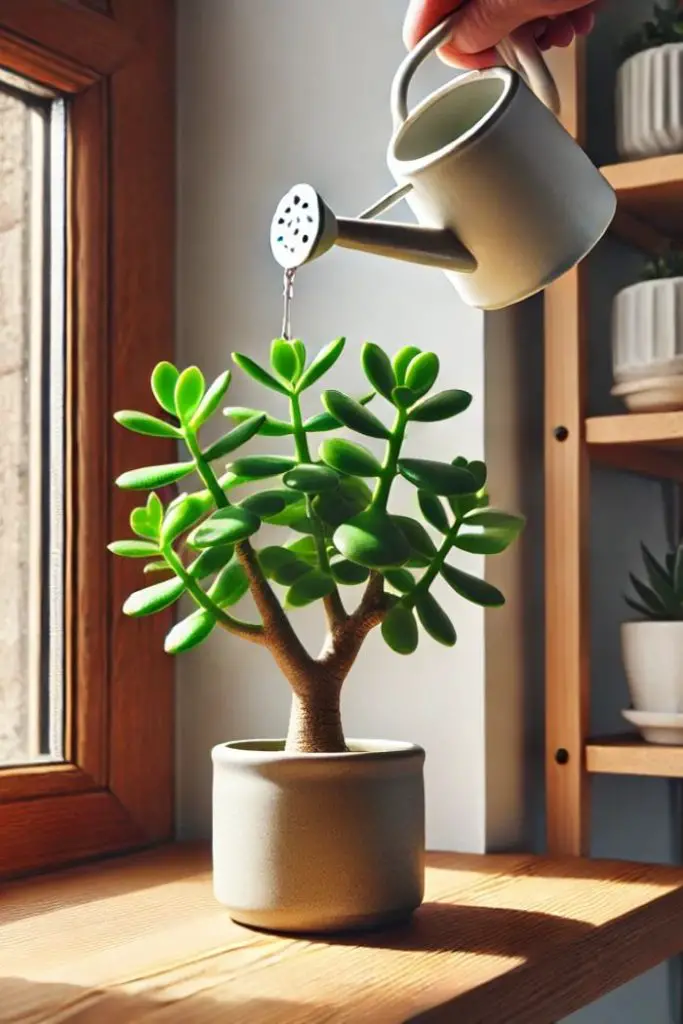
Signs of Overwatering
To ensure the peak health of your jade plant, be vigilant for signs of overwatering as you care for its watering needs. Overwatering can lead to yellowing leaves and wilting stems.
If you notice the lower leaves turning yellow and feeling mushy to the touch, it may be an important indication of excessive moisture in the soil. Wilting stems, where the upper parts of the plant look healthy, but the lower stems are drooping and soft, can also suggest overwatering. These symptoms are vital indicators that your jade plant is receiving too much water.
Adjusting your watering routine by allowing the soil to dry out more between waterings can help prevent further damage and restore your plant’s health.
Best Watering Practices
For the best growth and health of your jade plant, it’s important to establish a consistent and mindful watering routine. Watering frequency plays a vital role in maintaining the soil moisture level that your jade plant needs. Allow the top 1-2 inches of the soil to dry out between waterings to prevent overwatering, which can lead to root rot.
When watering, make sure that water reaches the roots by watering the soil directly and avoiding getting water on the leaves. Use a well-draining potting mix to help prevent waterlogging and aid in root rot prevention.
Understanding Light Requirements
When growing a jade plant, it’s important to understand the specific light requirements for best growth. Light exposure plays a vital role in the health and development of your jade plant. These plants thrive in bright, indirect sunlight. Placing your jade plant near a window where it can receive ample natural light is ideal. However, be cautious of exposing it to direct sunlight for extended periods as this can lead to sunburns on the leaves.
Insufficient light can result in leggy growth, where the stems become elongated and weak. On the other hand, too much light can cause the leaves to become scorched and turn brown. By understanding the light needs of your jade plant, you can ensure ideal conditions for healthy plant growth.
Monitoring the light exposure and adjusting the placement of your jade plant accordingly will help you maintain a vibrant and flourishing plant. Remember, finding the right balance is key to promoting strong and compact growth in your jade plant.
Fertilizing Tips
Understanding the light requirements for your jade plant is crucial to its health, and now we’ll discuss effective fertilizing tips to support its growth and vitality. When it comes to fertilizing your jade plant, ensuring proper soil nutrition is essential.
Use a balanced, water-soluble fertilizer with equal parts nitrogen, phosphorus, and potassium during the growing season. This will promote healthy foliage and overall growth.
Additionally, consider incorporating growth supplements into your fertilizing routine. Products containing micronutrients like iron, magnesium, and calcium can enhance the health and appearance of your jade plant. These supplements help ensure that your plant is receiving all the necessary nutrients it needs for excellent growth.
Remember to fertilize your jade plant sparingly during the winter months when its growth slows down. Over-fertilizing can lead to salt buildup in the soil, causing root damage. By following these fertilizing tips and providing your jade plant with the nutrients it needs, you can promote lush foliage and vibrant growth.
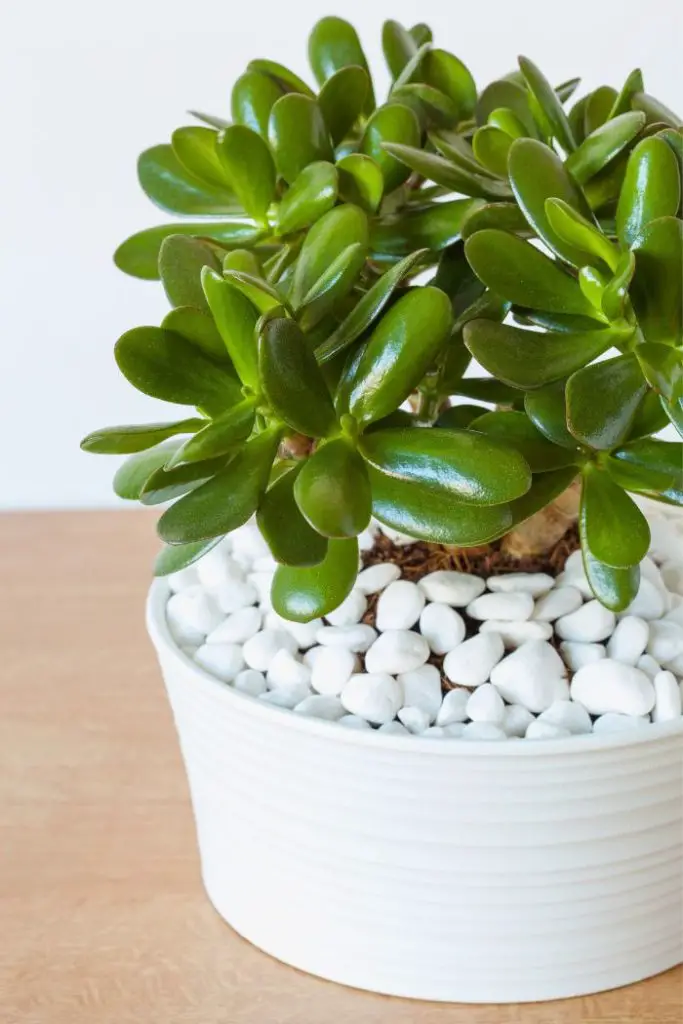
Pruning for Bushier Growth
To encourage bushier growth in your jade plant, strategically prune the stems and branches to promote denser foliage. Pruning techniques play an important role in shaping the growth of your plant.
Begin by identifying any leggy or overgrown stems that hinder compact growth. Using sharp, clean pruning shears, make precise cuts at a 45-degree angle just above a leaf node to encourage new growth.
Branch trimming is another effective method to stimulate branching and denser foliage. Focus on cutting back longer branches to promote a fuller appearance. When shaping your jade plant, consider the overall symmetry and balance of the plant to achieve an aesthetically pleasing look.
Remember to prune with purpose, as over-pruning can stress the plant. By implementing these growth tips and shaping methods, you can help your jade plant thrive and develop into a lush, bushy specimen that will bring a touch of nature into your living space.
Dealing With Pests
To guarantee the health and vitality of your jade plant, identifying and promptly addressing any pest infestations is essential. Natural pest control methods are effective in keeping your plant free from harmful insects. One strategy is introducing beneficial insects like ladybugs or lacewings that feed on common jade plant pests such as aphids or spider mites. Additionally, neem oil, a natural pesticide, can be used to deter pests without harming your plant.
Preventing pest infestations is key to maintaining a thriving jade plant. Regularly inspect your plant for any signs of pests like yellowing leaves, sticky residue, or webbing. Quarantine any new plants before introducing them to your jade plant to prevent the spread of pests. Ensure proper air circulation around your plant and avoid overwatering, as excess moisture can attract pests.
Propagating Your Plant
When propagating your jade plant, start by selecting a healthy stem cutting from the parent plant. To propagate through leaf propagation, choose a healthy leaf and let it dry for a day or two to form a callus. Plant the callused end into a well-draining soil mix, ensuring it’s slightly buried. Keep the soil moist but not waterlogged, and place the cutting in a warm, indirect light location.
For soil propagation, take a stem cutting with at least two sets of leaves and allow it to dry and callus for a few days. Plant the cutting in a well-draining succulent or cactus mix, burying the end slightly. Water the soil lightly and place the pot in a warm, bright spot with indirect sunlight.
Both leaf and soil propagation methods can be successful with jade plants, so choose the method that works best for you and enjoy watching your new plant grow and thrive.
Repotting When Necessary
Consider repotting your jade plant when it outgrows its current container or shows signs of root-bound stress. Repotting is crucial to guarantee your plant continues to thrive. Look for indicators like roots circling the pot’s bottom or growing through drainage holes.
To repot, gently remove the plant from its current container, loosen the roots, and place it in a new pot with fresh well-draining soil. Make sure the new pot has proper drainage to prevent waterlogging.
If your jade plant is root-bound, there are solutions to help alleviate the stress on the roots. You can carefully trim some of the roots or tease them apart before repotting. This will promote new root growth and prevent the plant from becoming pot-bound again too quickly. Additionally, consider using growth stimulants in the new soil to promote healthy root development after repotting.
Following these repotting techniques will give your jade plant the space it needs to continue flourishing.
Winter Care Guide
Prepare your jade plant for the winter season by adjusting its care routine to guarantee it remains healthy and thriving in the colder months. During winter, jade plants enter a period of dormancy, where their growth slows down. To make certain your plant’s well-being during this time, place it in a location with bright, indirect light as direct sunlight can still burn the leaves, even in winter. Water your jade plant less frequently in winter, allowing the soil to dry out more between waterings to prevent root rot. Cold drafts can harm your plant, so make sure it’s away from drafty windows or doors.
Maintaining a consistent temperature is essential for your jade plant during winter. Aim to keep it in an area with temperatures between 50-75°F (10-24°C). If the temperature drops significantly, consider using a plant heating mat to provide warmth. Fertilizing your jade plant is unnecessary during winter dormancy; resume feeding in spring when it’s actively growing again. By following these cold weather care tips, you’ll help your jade plant thrive through the winter months.
Troubleshooting Common Issues
To troubleshoot common issues with your jade plant, start by examining the leaves for any signs of discoloration or unusual spots. Yellowing or browning of the leaves could indicate overwatering, while wrinkled or shriveled leaves may signal underwatering. Adjust your watering schedule accordingly to restore the plant’s health.
If you notice sticky residue on the leaves or tiny insects like aphids, spider mites, or mealybugs, consider implementing pest prevention measures. Wiping the leaves with a gentle soapy solution or using neem oil can help deter these pests.
Additionally, providing your jade plant with growth stimulants like diluted fertilizer during the growing season can encourage lush foliage and vibrant growth. Make sure the plant receives adequate sunlight, as insufficient light can lead to leggy growth or sparse foliage. Regularly dust the leaves to prevent dust buildup, which can hinder photosynthesis.
Frequently Asked Questions
Can Jade Plants Be Grown Hydroponically?
Yes, jade plants can be grown hydroponically, providing a controlled environment for ideal growth. This method eliminates soil-related issues and allows for precise nutrient delivery. Indoor jade plants especially benefit from hydroponic setups, thriving in this controlled setting.
How Often Should I Rotate My Jade Plant for Even Growth?
To guarantee even growth, rotate your jade plant every 2 weeks. This practice helps prevent leaning towards the light source, promoting balanced development. Remember to prune regularly and consider propagation methods for new plants.
Is It Safe to Use Tap Water for Watering Jade Plants?
Yes, it’s safe to use tap water for watering jade plants, but let it sit for 24 hours to allow chlorine to dissipate. Make sure you water when the top inch of soil is dry. Jade plants prefer well-draining soil, moderate sunlight, and minimal pruning.
Can Jade Plants Thrive in a Terrarium Environment?
In a terrarium, jade plants encounter challenges like limited space and airflow. Make sure they receive adequate light, preferably from a south-facing window or a grow light. Monitor soil moisture carefully to avoid overwatering in this enclosed environment.
Are There Any Companion Plants That Benefit Jade Plants?
When selecting companion plants for your jade, choose ones with similar soil composition and watering needs. Some beneficial companions include spider plants and snake plants. These plants can help repel pests and thrive in similar sunlight exposure.
Conclusion
To sum up, cultivating a healthy jade plant necessitates careful attention to the following aspects:
- Pot size
- Location
- Drainage
- Soil mix
- Watering
- Propagation
- Repotting
- Winter care
- Troubleshooting common issues
By adhering to these guidelines, you can guarantee your jade plant thrives and continues to enhance the beauty of your indoor space.
Remember to provide the proper care and maintenance to keep your jade plant healthy and vibrant.



